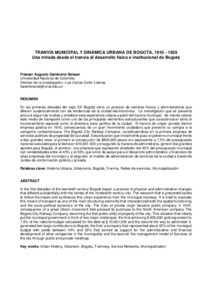Mostra el registre d'ítem simple
Tranvía municipal y dinámica urbana de Bogotá, 1910 – 1929: una mirada desde el tranvía al desarrollo físico e institucional de Bogotá
| dc.contributor.author | Zambrano Salazar, Frasser Augusto |
| dc.coverage.spatial | east=-74.07475411891937; north=4.599316425375995; name=La Catedral, Bogotá, Bogota, Colòmbia |
| dc.date.accessioned | 2017-10-04T16:05:34Z |
| dc.date.available | 2017-10-04T16:05:34Z |
| dc.date.issued | 2017-06 |
| dc.identifier.citation | Zambrano Salazar, F. A. Tranvía municipal y dinámica urbana de Bogotá, 1910 – 1929: una mirada desde el tranvía al desarrollo físico e institucional de Bogotá. A: Seminario Internacional de Investigación en Urbanismo. "IX Seminario Internacional de Investigación en Urbanismo, Barcelona-Bogotá, Junio 2017". Barcelona: DUOT, 2017. |
| dc.identifier.issn | 2385-7714 |
| dc.identifier.uri | http://hdl.handle.net/2117/108349 |
| dc.description.abstract | En las primeras décadas del siglo XX Bogotá inició un proceso de cambios físicos y administrativos que difieren sustancialmente con las tendencias de la ciudad decimonónica. La investigación que se presenta procura seguir las huellas y sintetizar esta experiencia urbana a partir del tranvía municipal. Se intenta valorar este medio de transporte como uno de los principales elementos estructurantes que caracterizaron tanto el funcionamiento espacial como la dinámica socio política de la ciudad. El tranvía de origen privado devino empresa pública en 1910, consecuencia de un gran movimiento ciudadano que presionó su compra a la compañía norteamericana The Bogotá City Railway Company, constituyéndose en la primera empresa de servicios públicos de propiedad de la ciudad. Esta situación que inicialmente puso al gobierno municipal frente a dos grandes retos: el primero la consecución de $800.000 pesos oro equivalente a 7.5% del presupuesto nacional calculado para la fecha en $10.651.500 y el segundo la manera de administrarla, generó dos grandes aportes para Bogotá, el primero: una empresa que representó alrededor del 42% del presupuesto municipal con rentabilidades entre el 45% y el 55% que sirvió de apoyo para el desarrollo administrativo y financiero de otras empresas del municipio y el segundo: el modelo de administración de servicios de la ciudad a través de Juntas de conformación pública y privada. |
| dc.description.abstract | In the first decades of the twentieth century Bogotá began a process of physical and administrative changes that differed substantially with the trends of the nineteenth century city. The research that is presented seeks to follow the traces and synthesize this urban experience from the municipal tramway. It is tried to evaluate this means of transport as one of the main structuring elements that characterized both the spatial functioning and the socio-political dynamics of the city. The tram of private origin became public company in 1910, consequence of a great citizen movement that pressed its purchase to the North American company The Bogota City Railway Company, becoming the first public utility of property of the city. This situation that initially put the municipal government in front of two major challenges: the first achieving $ 800,000 gold equivalent to 7.5% of the national budget calculated for the date at $ 10,651,500 and the second the way to administer it, generated two large contributions to Bogotá, the first: a company that represented about 42% of the municipal budget with yields between 45% and 55% that served as support for the administrative and financial development of other companies in the municipality and the second: the management model of Services of the city through public and private meetings. |
| dc.format.extent | 23 p. |
| dc.language.iso | spa |
| dc.publisher | Departament d’Urbanisme i Ordenació del Territori. Universitat Politècnica de Catalunya |
| dc.relation.ispartof | Seminario Internacional de Investigación en Urbanismo (9è: 2017: Barcelona, Bogotà) |
| dc.rights | Attribution-NonCommercial-NoDerivs 3.0 Spain |
| dc.rights.uri | http://creativecommons.org/licenses/by-nc-nd/3.0/es/ |
| dc.subject | Àrees temàtiques de la UPC::Urbanisme |
| dc.subject.lcsh | Sociology, Urban -- Colombia -- Bogotá |
| dc.subject.lcsh | Street-railroads -- Colombia -- Bogotá |
| dc.subject.other | Historia Urbana |
| dc.subject.other | Urbanismo |
| dc.subject.other | Bogotá |
| dc.subject.other | Tranvía |
| dc.subject.other | Redes de servicios |
| dc.subject.other | Municipalización |
| dc.subject.other | Urban History |
| dc.subject.other | Urbanism |
| dc.subject.other | Bogota |
| dc.subject.other | Tramway |
| dc.subject.other | Service Networks |
| dc.subject.other | Municipalization |
| dc.title | Tranvía municipal y dinámica urbana de Bogotá, 1910 – 1929: una mirada desde el tranvía al desarrollo físico e institucional de Bogotá |
| dc.type | Conference report |
| dc.subject.lemac | Sociologia urbana -- Colòmbia -- Bogotà |
| dc.subject.lemac | Tramvies -- Colòmbia -- Bogotà |
| dc.identifier.doi | 10.5821/siiu.6409 |
| dc.identifier.dl | B-15.590-2013 |
| dc.rights.access | Open Access |
| local.citation.contributor | Seminario Internacional de Investigación en Urbanismo |
| local.citation.pubplace | Barcelona |
| local.citation.publicationName | IX Seminario Internacional de Investigación en Urbanismo, Barcelona-Bogotá, Junio 2017 |


